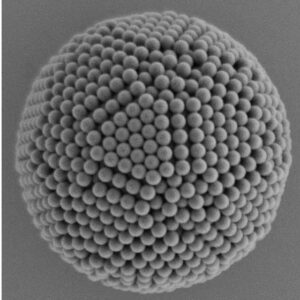In bulk, monodisperse colloidal particles crystallize into close-packed structures upon reaching a critical packing fraction. However, confining elements can change this self-assembly process. A particularly interesting confinement are emulsion droplets, where curvature and interfaces impose restrictions on the ability of colloidal particles to crystallize.
We experimentally investigate the self-assembly of sub-micron colloidal particles in spherical emulsion droplets produced by microfluidics and focus on fundamentally understanding this confined self-assembly process. We have demonstrated that such clusters can exist as magic number clusters, discovered clusters with decahedral symmetry, explored the phase diagram as a function of cluster size and developed a systematic understanding of defect structures. We work in close collaboration with the groups of Prof. Michael Engel and Prof. Erdman Spiecker to analyse the 3D structure with advanced microscopy methods (Spiecker group) and to study the formation kinetics and thermodynamic properties of these confined colloidal clusters in simulation (Engel group).

Key Related Publications
Junwei Wang, Umair Sultan, Eric S. A. Goerlitzer, Chrameh Fru Mbah, Michael Engel, Nicolas Vogel
Structural Color of Colloidal Clusters as a Tool to Investigate Structure and Dynamics
Adv. Funct. Mater. 2019, 1907730
Chrameh Fru Mbah, Junwei Wang, Silvan Englisch, Praveen Bommineni, Nydia Roxana Varela-Rosales, Erdmann Spiecker, Nicolas Vogel & Michael Engel
Early-stage bifurcation of crystallization in a sphere
Nat Commun. 2023 14, 5299
J. Wang. C. F. Mbah, T. Przybilla, B. A. Zubiri, E. Spiecker, M. Engel, and N. Vogel
Magic Colloidal Clusters as Minimum Free Energy Structures
Nature Comm. 2018, 9, 5259
Junwei Wang, Jonathan Martín-González, Lukas J. Römling, Silvan Englisch, Chrameh Fru Mbah, Praveen Bommineni, Erdmann Spiecker, Michael Engel, Nicolas Vogel
Breakdown of Magic Numbers in Spherical Confinement
ACS Nano 2025 19 (12), 11702-11711
Key persons